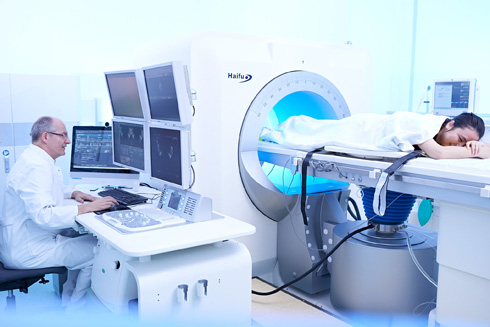HIFU-Therapy for liver cancer
Very careful minimally invasive treatment of liver cancer.
The institute of the diagnostic and interventional radiology in Frankfurt offers as one of the first German-speaking medical centers the treatment with the ultrasound guided HAIFU system. The specific feature of this device is the possibility of the treatment of evil tumors,
e.g. of the upper abdomen organs. The application of the HAIFU treatment with a huge number of illnesses was picked out as a central theme during the last years and achieved with the treatment of goodnatured and evil tumor illnesses good results. Possible operational areas are, for example, the treatment of inoperable tumors of the pancreas, the liver, the kidney, the breast, the bones, as well as the treatment of
wombmyomas (good-natured rank growth of the womb musculature), adenomyosis of the womb and fibroadenomas of the breast.
In the following it is entered on the HAIFU therapy with liver cancer.
What is HIFU about?
The name is a short-term for High-Intensity Focused Ultrasound. Ultrasound calls high frequent oscillations witch lie above the human hearing threshold (> 16kHz). For diagnostic purposes the ultrasound is used quite for decades. Nevertheless, with the HIFU substantially higher energy is generated in contrast to the diagnostic ultrasound. This functions by the grouping of the rays by special converters which focus the rays on few millimeters of the measuring area. (The same effect like with sun-rays bundling up magnifying glass) The therapeutic effect of the ultrasound is given about the originating temperatures in the aim area from up to 80° degree which kills tumor cells actually (Tumorablation).
HIFU is admitted for the medical use with the person (European CE and American FDA-certification). The effectiveness and the security of the procedure was already documented in many studies. Nevertheless, HAIFU treatment appears in Europe as a new used procedure, so that
other studies around the applicational spectrum are necessary.
When is the HIFU-Therapy applied at Patients with liver cancer?
With the topical treatment of liver tumors the surgical operation, liver-transplantation, radiotherapy and chemotherapy are valid as a standard procedure. If the tumor should be reduced before the operation, or a surgical tumor distance is not possible, careful minimum-invasive procedures, so-called bar ablative procedures can be applied in well-chosen cases. The surgical intervention, including the liver transplantation, offers to the hepatocellulare carcinoma (HCC, the most common liver tumor) a curative treatment. However, this surgical intervention is often not possible on account of the tumor qualities like size, number and situation of the tumor, or because of advanced illness
stadium. Minimal-invasive bar ablative procedures like laser-induced therm therapy, radiofrequezablation (RFA) and ethanolinjektion become applied as an alternative, or in addition to the surgical action. With these minimal-invasive methods needleshaped instruments are introduced in the body. Besides, the selective internal radiotherapy (SIRT) and trans-arterial (Chemo-) Embolisation (TACE) can be applied, with which the tumor supplying vessels are sounded out. Now HIFU shows an innovative, non-invasive form of treatment which can be applied as an alternative or as a supplement to the treatment by hepatocellulare carcinomas and liver metastases.
Advantages of the HIFU-Treatment
HIFU is non-invasive and thereby connected with a very low appearance rate of side effects, in contrast to surgical methods or other bar ablative procedures. This is based on the fact that no cut is necessary for the HIFU treatment and also no instruments must be introduced in the body. This quality extends the spectrum of treatment on inoperable tumors which lie close to big vessels, cystic ducts or border on the diaphragm. Bigger vessels are not injured by the focused ultrasound and the surrounding tissue is better spared by HIFU than by an operation. Also the HIFU treatment is suited for the tumor reduction in palliative intention. (for the improvement of the life quality) Before all HIFU is indicated with the locally advanced tumors, which can only be operated under the biggest risk. In comparison to a chemotherapy the HIFU treatment offers the advantage to be practicable by a single meeting. Besides, HIFU can be often repeated arbitrarily with a rest infestation or a returning tumor infestation. We expect a total of one at least equivalent tumorablation with HIFU in comparison to other bar ablative procedures, with an enlarged indication spectrum and a lower side-effect rate.
Which Patients are suitable for a HIFU treating?
The feasibility of a HIFU treatment must be cleared for every patient individually.
As general indications can be valid:
- secure inoperable HCC / secure inoperable liver metastasis
- tumor is representable by means of ultrasound
- tumor size up to about 5 cm, if necessary in combination with a before carried out trans-arterial embolisation
- several (max.4) tumor knots who size max. 10 cm
- primary tumor should be treated ( OP,chemotherapy)
- expected survival time of more than 3 months
- good general condition of the patient
- the patient must be able of anaesthesia
Which patients are not suitable for a HIFU-Therapy?
- Tumor involves more than 50% of the liver
- vague tumor suffering
- more than 4 metastasis regions
- distant metastases
- hardly limited liver function
- bad general condition of the patient
- bad coagulation
- inflammation of the liver or the cystic ducts
Before the treatment
Preparatory measures are inalienable for a successful treatment. It is important that the day before an intestinal preparation occurs to reduce, e.g. intestinal air. For this you receive a purge and three liters of liquid. You must take the purge the day before about 14 o'clock and drink in addition 1 liter of laxative liquid within one hour. You drink the second one and the third litre again within one hour at 16 o'clock and 18 o'clock.
From midnight you drink nothing more and on the day of treatment in the morning a catheter is laid. The skin of the belly wall is cleaned immediately before the therapy, in addition, it is shaved, degreased and degased. Coagulation-restraining drugs (e.g. Marcumar, Xarelto, Plavix, aspirin) must be set down seven days before the HAIFU treatment after an arrangement with all involved doctors. Also twelve hours of sobriety before the therapy must be kept, this means no food, drinking or smoking. The taking from regularly taken drugs should only be continued after consultation with the doctors.
How does the treatment run off?
First you are taken up to the HAIFU treatment 3-4 days in hospital. The therapy is often carried out under general anesthesia, so that you can lie absolutely quietly and feel no pains. Hence, an appointment is agreed with you before the treatment in the anesthesiology for the anesthesia conversation and the premedication. The treatment is to be carried out also possibly in local anesthesia. With this alternative way the anesthesia complications are even more seldom, but you might feel little pain. On the day of the stationary admission preparatory measures are carried out and blood is taken to control the regulation of the coagulation. The treatment takes place on the second day. The therapy duration is depending on the tumor size and the situation in the body. The real treatment mostly lasts 1-3 hours, the whole duration with preparations and evaluations encloses approx. 2-6 hours. The anesthetists control during the treatment consecutively heart frequency, blood pressure and respiration. The complication risk during the anesthesia is very low, because it concerns a not surgical intervention.
After the treatment you will awake under supervision.

Aftercare
We take trouble that you have no pains after the treatment. Should you feel nevertheless pains, don't hesitate to contact us, so that we can go forward directly against pains. According to your subjective feeling you can already take a normal meal in the evening to yourselves. Overnight the infusion will be left for safety reasons. The next morning, to the control the success of treatment, an ultrasonic investigation is carried out. According to your condition you can be dismissed after 48-hour supervision again home. If you feel fine, you can already resume after 3 days of protection your usual activities. The appointments for necessary controlling investigations are told you before your dismissal. Certain controlling investigations (ultrasound CT, MRT, perhaps PET) are necessary after the HIFU treatment in certain time intervals.
These enable on the one hand to estimate the therapy success, and to exclude late expected complications on the other hand.
Risks and Side-effects of the HAIFU-Therapy
The tumor treatment by means of HIFU is a procedure really poor in risk with serious side effects and few all together. Paraesthetics or light pains are often felt at the skin place which lies over the treated tumor. This discomfort mostly stops soon, decreases by itself and needs no other therapy. Skin changes appear in less than 5% of the patients at the irradiated place. They can reach, from a light reddening about odemas of the skin up to small skin vesicles. These skin reactions can be supplied with cooling creams, so that they disappear after some days again. After the treatment in approx. 5-10% of the cases light fever appears which is treated with fever-lowering means and fades normally away after 24h again. Changes of the blood and a light increase of the inflammation value CRP in the blood can appear as a token of a mild, unspecific inflammation reaction. To the HIFU area adjoining hollow organs can be injured very seldom (less than 1% of the cases). Also a pus aggregation can be formed by infection, here of the destroyed tumor tissue.
Who takes over the costs of the treatment?
Because it concerns a new procedure,the HIFU therapy (still) does not belong to the standard achievements of the legal health insurance schemes. With interest in a HIFU treatment you should turn to your health insurance scheme and apply for an assumption of costs which is granted by some health insurances. Nevertheless, currently it still concerns single decisions. With these ,,administrative matters" we help you with pleasure. If you are insured privately,the medical costs are completely carried by your insurer, or are subsidized at the request. Whether your aid place also takes overcosts proportionately, you would have to clear in the approach directly.
